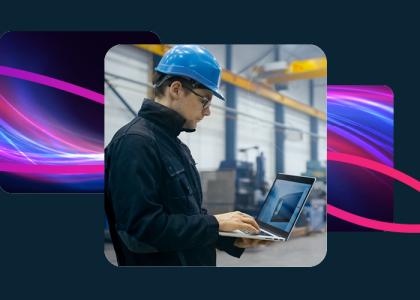Overcoming resistance to digital HR transformation in manufacturing

With digital transformation across the factory floor at the forefront of many manufacturing organisations’ growth strategies, there’s increasing pressure to modernise other processes, including HR.
It’s tricky, though. Despite the benefits of using digital tools as part of a people strategy, manufacturers often face resistance to these changes. This resistance, whether cultural or technical, can slow down progress and hinder the organisation’s competitiveness.
The key to overcoming these barriers lies in adopting a people-centred approach. By prioritising the needs and concerns of employees, the transition is likely to be smoother, maximising engagement and unlocking the full potential of digital HR transformation.
Why digital transformation matters for HR
The manufacturing industry is no stranger to technological advancements, yet HR often remains stuck in outdated systems and manual processes.
Modern HR technology offers many advantages, including:
- Improved workforce planning
Predictive analytics allow teams to forecast staffing needs, making sure the right people are in the right places at the right times, reducing gaps in productivity.
- Enhanced employee experience
Self-service tools allow employees to access payslips, request time off and update personal information, removing admin bottlenecks and freeing up the HR team’s time.
- Streamlined operations
Automating routine tasks allows your HR team to focus on growth initiatives such as talent development and employee wellbeing strategies, rather than wading through admin.
The common barriers to digital HR transformation
Despite the obvious benefits, resistance to digital transformation persists. Like any transformation, bringing in new digital HR solutions will present a set of challenges. Some of the main issues include:
- Inability to fit with legacy systems
Many companies’ existing systems weren’t designed to integrate with modern versions. This creates compatibility issues and makes adopting new technology a real challenge without navigating significant overhauls. A mix of the upfront costs and potential downtime required means it’s not surprising that leaders are hesitant to take the plunge.
- Cultural resistance across teams
The manufacturing workforce often spans multiple generations, and long-standing employees can be accustomed to traditional processes. Bringing in new technologies is likely to spark concerns over job security or create frustration, particularly among those who aren’t digitally savvy.
- High implementation costs and ROI concerns
When profit margins are tight and overheads are continually rising, it’s understandable that leaders are careful about where they decide to invest.
Adopting digital tools requires not only financial commitment, but time and resources for training and change management. Without a clear and immediate return on investment (ROI), executives may be hesitant to fully support transformation.
Solutions for a successful transformation
The simplest, best step to overcome these barriers is for manufacturers to prioritise their people. Putting your workforce at the centre ensures digital transformation aligns with workforce needs and encourages buy-in at every level.
Here’s how to make it happen:
1. Align technology with workforce goals
Start by identifying what’s directly impacting employees’ day-to-day work. For instance:
- Are HR processes overly time-consuming or manual?
- Are employees frustrated by regular payroll delays or errors?
Invest in tools that address these specific challenges and highlight how the technology will directly benefit workers. For example, you could save 4 hours of admin per week, or give employees the ability to view their payslip in real time.
2. Leverage intuitive and accessible HR tools
Choose technology platforms that have been designed with end users in mind. Self-service portals, mobile apps and user-friendly dashboards can all make a difference in adoption rates. Tools that enable employees to manage tasks such as accessing their payslips or updating information without HR intervention demonstrate immediate value.
3. Upskill and train your workforce
Resistance often stems from fear of the unknown. Training programs can help employees gain confidence in using new HR systems.
It’s best to consider creating tailored training paths for different users within your workforce. For example, some employees might benefit from hands-on, guided workshops, while others will prefer virtual, gamified online training.
This not only bridges any skill gaps, but also shows employees the company is invested in their success.
4. Communicate transparently
Open, honest communication is essential throughout transition periods. Employees want to know:
- What’s changing and why
- How it will impact their roles
- What support they can expect
Sharing the long-term vision for the business and how the changes will benefit everyone individually is likely to improve uptake, as is addressing any concerns upfront. Providing regular updates and offering opportunities for feedback will also help to minimise resistance and build trust.
5. Start small, scale smartly
Taking a phased approach allows manufacturers to test and refine new strategies. Start with smaller, high-impact initiatives, such as introducing self-service tools, then use early successes to demonstrate the value of digital tools. This makes it easier to build momentum and scale.
Putting people first: the key to lasting change
The most successful digital HR transformations aren’t just about implementing new technologies. They are about a fundamental change in how a company thinks about its workforce, shifting focus from the technology itself to the benefits it can deliver. This could include:
- More streamlined communication between employees and HR teams
- Greater flexibility in scheduling to accommodate work-life balance
- Higher trust from employees when pay is consistently accurate and on time
By adopting this mindset, manufacturing leaders can make their workplace somewhere people enjoy working. This translates directly into improved business outcomes, from better retention rates to increased productivity.
Discover real-life examples of manufacturing organisations that have realised the benefits of digitalising their HR and payroll.



